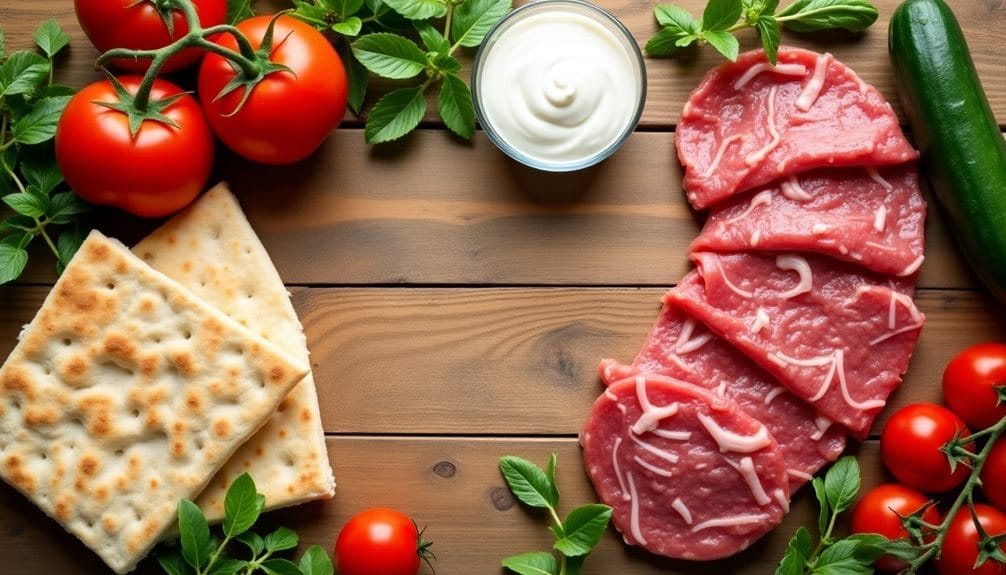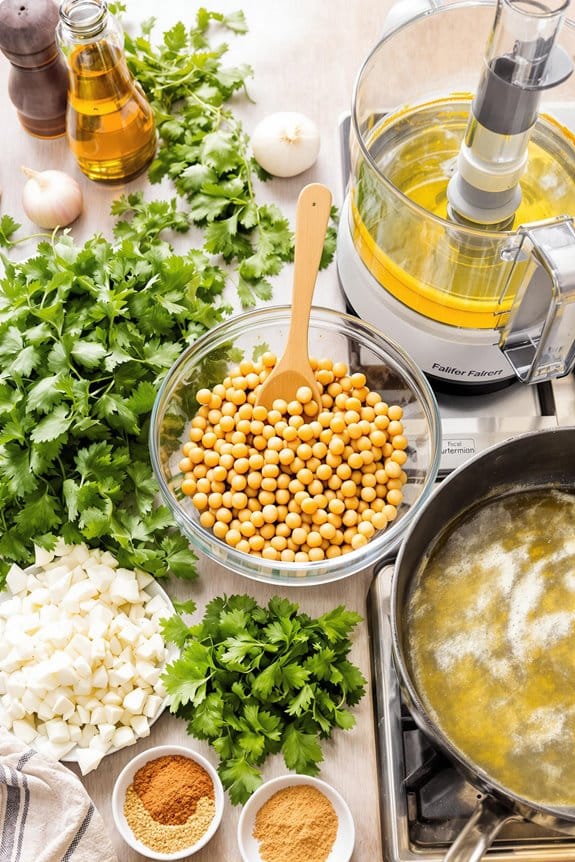Did you know that Greek cuisine, including the ever-popular gyro, ranks among the top five healthiest diets worldwide? Now, imagine transforming your regular, mundane Tuesday evenings into a Greek Gyro Night, a culinary journey bringing the heart of the Mediterranean right onto your dinner table. You’d not only be indulging in a delicious, customizable meal but also reaping numerous health benefits. But how does one prepare an authentic gyro at home? What ingredients are essential and what techniques must you master? Stick around, you’re about to set off on a mouth-watering adventure.
History
Delving into the history of the Greek Gyro, you’ll find it’s a dish steeped in tradition. Originating from Greece, the word “gyro” translates to “turn,” hinting at the traditional method of roasting meat on a vertical spit. As you explore further, you’ll discover that this delicious wrap wasn’t always known as a gyro. It began as a “doner kebab,” a creation of Turkish immigrants in Greece.
Over time, Greeks adapted the dish, adding their own twist with local ingredients. The hearty gyro you know today, full of succulent meat, fresh veggies, and tangy tzatziki sauce, is a result of this culinary evolution. It’s a showcase of Greece’s vibrant street food culture, recognized worldwide for its unique blend of flavors.
Even if you’re thousands of miles away from Greece, you can still enjoy a tasty gyro at home. By using quality ingredients and following traditional methods, you’re not just making a meal, you’re partaking in a historical culinary tradition. So, the next time you bite into a gyro, remember, you’re enjoying a piece of Greece’s rich cultural heritage.
Recipe Cooking Steps
Prepare for a Greek Gyro Night that brings together a delightful mix of flavors, textures, and freshness. This simplified version of the traditional Greek street food is easy to make at home, yet doesn’t compromise on the authentic taste. The savory and tender lamb or beef strips, the crunch of fresh vegetables, and the tangy creaminess of tzatziki sauce all wrapped in a warm pita bread come together to create a meal that is as satisfying as it is delicious. This recipe also offers versatility, allowing you to customize your fillings based on your preference or what’s available in your pantry.
Cooking a Greek Gyro at home is a fun and rewarding experience. It’s a great way to bring a touch of Greek cuisine to your kitchen without the need for complex cooking techniques or hard-to-find ingredients. The key to a delicious Greek Gyro lies in the quality of the ingredients used and in the balance of flavors. So, let’s gather our ingredients and start cooking this delicious meal for a memorable Greek Gyro Night.
Ingredients:
- 500g of lamb or beef strips
- 4 pieces of pita bread
- 1 cucumber
- 2 tomatoes
- 200g of tzatziki sauce
Start by marinating the lamb or beef strips in a mixture of olive oil, lemon juice, garlic, oregano, and salt for at least an hour. Once marinated, grill or pan-fry the meat until it’s cooked to your preference. While your meat is cooking, slice your cucumber and tomatoes into thin strips. Warm the pita bread in an oven or on a grill until it becomes soft and pliable. When everything is ready, assemble your gyro by spreading a generous amount of tzatziki sauce on the pita bread, then layering the cooked meat and vegetable strips. Fold the pita bread over the fillings and your Greek Gyro is ready to be served.
When preparing your Greek Gyro, remember to pay attention to the quality of your ingredients. Fresh vegetables will give you the best crunch and flavor. Although lamb or beef is traditionally used, you can substitute it with chicken or even plant-based meat if you’re looking for a healthier option. The tzatziki sauce can be bought ready-made, but you can also make it at home for an even more authentic flavor. You can prepare it ahead of time and store it in the fridge to let the flavors meld together. Why not pair your Greek Gyro with a side of Greek salad or fries for a complete and satisfying meal? Enjoy your Greek Gyro Night!
Step 1. Marinating the Meat

Let’s start with the most flavorful part of the Greek Gyro – marinating the meat. This is where the magic truly happens, as the marinade works its way deep into the meat, infusing it with a medley of irresistible flavors.
Grab your chosen meat, lamb or beef strips, and place them in a bowl. You’ll need a mixture of olive oil, fresh lemon juice, minced garlic, dried oregano, and a good pinch of salt. Pour this blend over your meat, ensuring each piece is well-coated. Don’t rush this process; the longer the meat soaks up these flavors, the better. Ideally, leave it to marinate in the fridge for at least an hour. If you’ve got more time, let it sit overnight. Trust me, your patience will pay off.
Step 2. Cooking the Marinated Meat
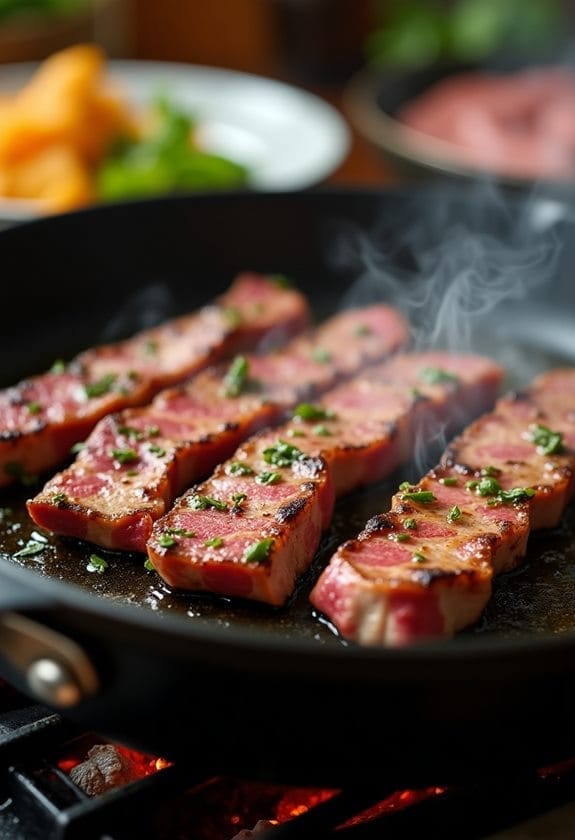
After letting the meat steep in the marinade’s flavor bath, it’s time to get cooking. Heat up your grill or stovetop pan to a medium-high setting. You’re aiming for a sear that locks in all the succulent juices and spices. Once it’s hot, add your marinated meat. Whether it’s lamb or beef, you’ll want to cook it until it’s just right for you. Some like it medium-rare, others prefer well-done; it’s all up to your personal preference.
Just remember, don’t overcrowd the pan or grill. Give the strips room to sizzle and dance around. You’re not only cooking here; you’re coaxing out all the rich flavors infused by the marinade. Turn them occasionally, ensuring each side gets a nice sear.
While the meat’s cooking, resist the urge to move on to prepping the veggies — that’s for our next segment. Instead, keep a watchful eye on your sizzling meat. Once it’s cooked to your liking, remove it from the heat and let it rest. This brief pause allows the juices to redistribute, ensuring every bite is mouthwateringly juicy. So, there you have it, the secret to cooking the marinated meat for your Greek Gyro Night. Enjoy the aroma and anticipate the feast!
Step 3. Preparing Fresh Vegetable Fillings
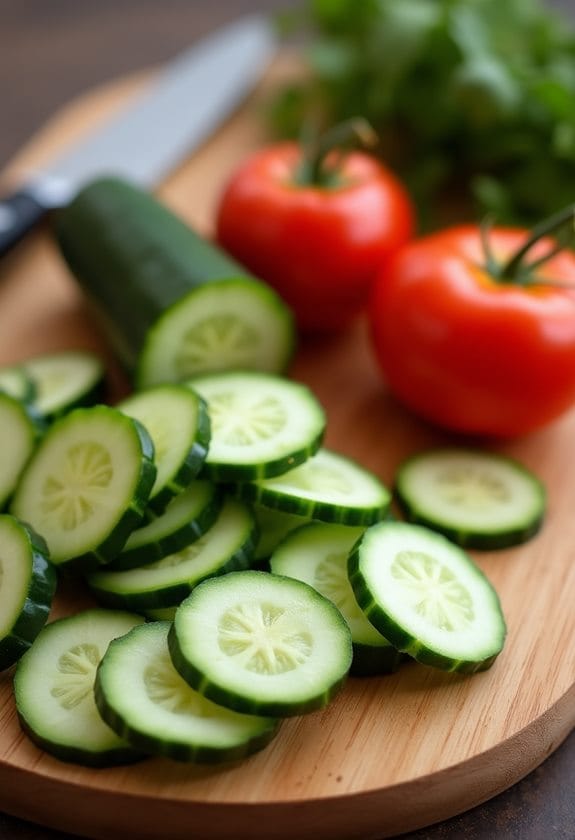
While your meat is resting, it’s the perfect time to tackle your fresh vegetable fillings. For the classic Greek Gyro, you’ll need a cucumber and some tomatoes. Grab your sharpest knife and get to slicing. You’ll want thin strips, just right for tucking into a warm pita pocket.
Now, don’t rush this part. It’s all about the texture here. Too thick and your veggies will overpower the tender meat. Too thin, and they’ll get lost in the sauce. So, take your time, find that Goldilocks zone. Once you’ve got your cucumber and tomatoes sliced, set them aside.
Let’s not forget the tangy tzatziki sauce. If you’ve got a store-bought one, that’ll do. But if you’re feeling a bit more adventurous, why not make your own? It’s simple, really. All you need is some Greek yogurt, a bit of grated cucumber, a splash of olive oil, and a pinch of salt. Mix them all together and voila, you’ve got a fresh, creamy tzatziki sauce ready to go.
With your fillings prepared, you’re one step closer to a perfect Greek Gyro night.
Step 4. Warming the Pita Bread

Now with your fresh vegetables and tzatziki sauce at the ready, it’s time to focus on the pita bread. This is a vital part of your gyro, as it holds all the delectable ingredients together. You don’t want it too hard or too soft, so pay attention to this step.
To warm your pita, first preheat your oven to 350 degrees Fahrenheit. Wrap a stack of four pitas in a damp cloth or kitchen towel. This will keep them moist and prevent them from drying out. Place the wrapped pitas on a baking sheet and let them heat in the oven for about 10 minutes.
If you’re short on time, you can also warm them up individually in a dry skillet over medium heat. Just watch them closely, as they can get crispy quickly. Flip them after about a minute, or when you see the first signs of browning.
Once your pitas are warm and pliable, they’re ready for the gyro assembly. But remember, don’t start assembling just yet. That’s a whole different process and we’ll get to it in the next step. For now, let’s just appreciate the soft, warm pita bread you’ve perfectly prepared.
Step 5. Assembling the Gyro
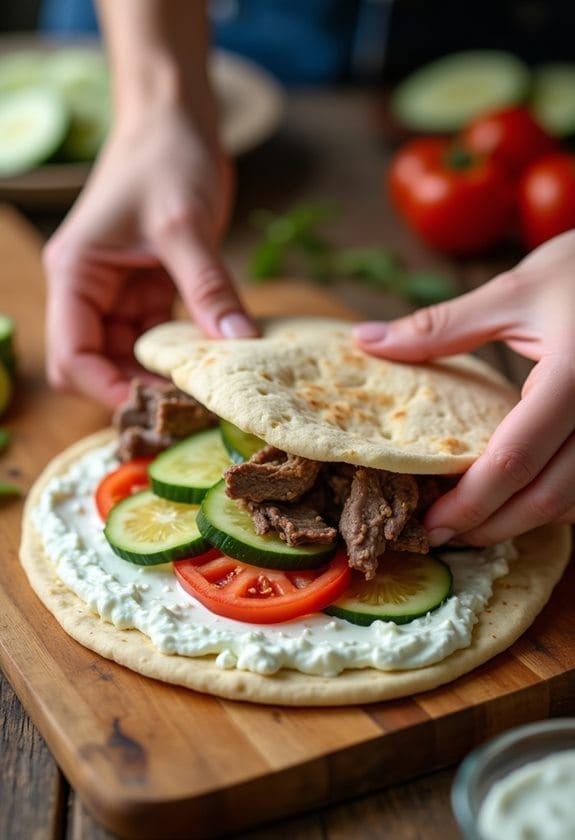
Gearing up for the final step, you’re now ready to assemble your Greek Gyro. It’s simpler than it sounds and with your ingredients at hand, you’re all set for a delightful culinary experience.
- Start by slathering a generous amount of tzatziki sauce on your warm pita bread. It’s the base of your gyro and amps up the flavor.
- Next, pile on the succulent, well-cooked lamb or beef strips. Guarantee there’s enough meat to enjoy in every bite.
- It’s time to add freshness with thin strips of cucumber and tomato. They provide the much-needed crunch and balance the richness of the meat.
- If you wish, sprinkle some chopped onions or lettuce for extra texture and flavor.
- Finally, fold the pita bread over the fillings, creating a neat pocket of goodness.
And voila! You’ve crafted a delicious Greek Gyro right in your kitchen. Don’t forget to serve with a side of fries or Greek salad to complete the meal. Now, it’s time to sit back, enjoy your homemade gyro, and bask in the glory of your culinary skills. Greek Gyro Night couldn’t get any better!
New Recipe
- Pepperoni and Hot Honey PizzaTry the tantalizing twist of pepperoni pizza with hot honey, where sweet meets heat—how will it transform your taste buds?
Final Thoughts
Jumping right into Greek cuisine need not be intimidating. Especially not with the versatile and universally loved Greek gyro. You’ve seen how simple it is to prepare at home, and how you can even customize it to suit your taste. It’s not just about the soft pita bread or the deliciously marinated meat. It’s about creating a balance of flavors with the freshness of the vegetables and the tangy richness of the tzatziki sauce.
Take this Greek Gyro Night as an opportunity to experience Greece from your kitchen. It’s more than just a meal, it’s a celebration of Greek culture, embodied in every bite of this delectable dish. And remember, the key to a great gyro lies in the quality of ingredients you use. So, go for fresh produce and high-quality meat. You can even try making your own tzatziki sauce.
Before you know it, you’ll be hosting your own Greek nights, impressing your friends and family with your newfound culinary prowess. So, don’t be hesitant, jump in and relish the delightful journey of making your own Greek gyro.

